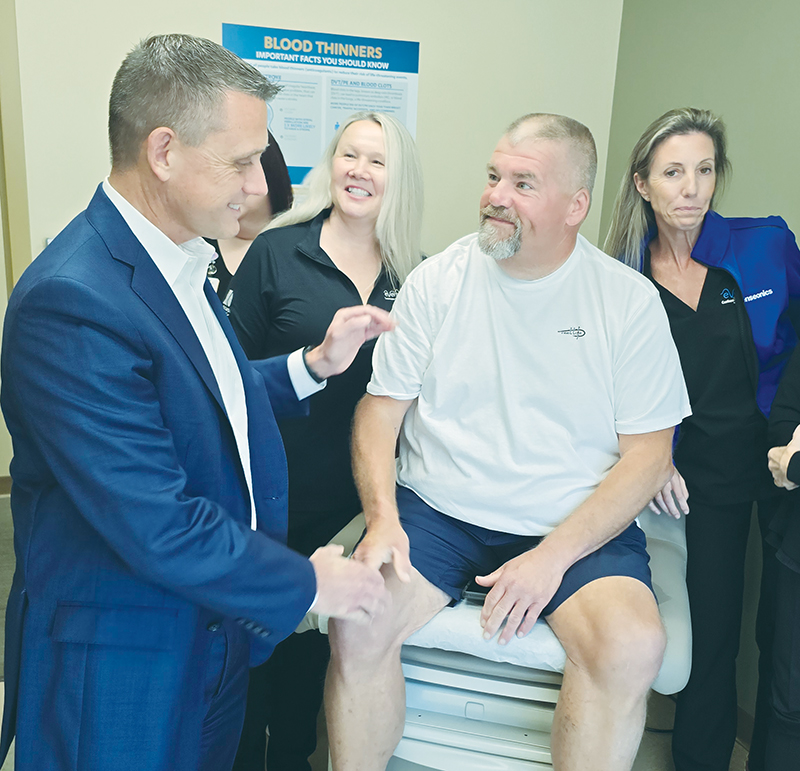 Dr. Raymond Weick congratulates his patient, Chris Walker, who was outfitted at Mercy Hospital St. Louis in October with the world's first 365-day continuous glucose monitor.
Dr. Raymond Weick congratulates his patient, Chris Walker, who was outfitted at Mercy Hospital St. Louis in October with the world's first 365-day continuous glucose monitor.The procedure to place the sensor under the skin on Chris Walker's arm took seconds; the look of relief on his face was immediate.
Walker, 56, has Type 2 diabetes, and was outfitted at Mercy Hospital St. Louis with the world's first 365-day continuous glucose monitor.
 Weick
Weick"It was pretty darn cool," said Dr. Raymond Weick of seeing Walker's reaction.
Mercy, based in Chesterfield, Missouri, forged a relationship with Senseonics Holdings, the maker of the Eversense 365 monitor, and the company's global
commercial partner, Ascensia Diabetes Care. Weick, Mercy regional physician executive, is the clinical executive sponsor of the project and Walker's doctor.
Most diabetics test their glucose with finger pricks or use sensors that must be replaced every few days. Walker had been monitoring his blood sugar the last several years with finger pricks and for the last several months with a glucose monitor that
often fell off his arm. He underwent the outpatient procedure in a doctor's office in early October.
Eversense 365 is designed to manage Types 1 and 2 diabetes in adults. The device has a sensor about twice the size of a Tic Tac that's inserted under the skin. The sensor communicates with a transmitter that is kept on top of the skin with a strong silicone-based
adhesive. The transmitter is removed once a day to be charged for about 15 minutes.
The device, calibrated by the patient at home once a week, lets Walker and his care providers monitor his glucose levels and trends for a year without replacing sensors.
"They explained everything from start to finish, and it all went just like they said," said Walker, who lives in Bourbon, Missouri. "After it was over, I really felt relieved that I'm not going to have the hassle of worrying about it falling off, while
going out and doing work around the yard and stuff like that."
Embracing innovation
Mercy and Senseonics in May announced a "first-of-its-kind relationship in a diabetes population management program."
They said the company's technology would be used across Mercy to advance diabetes management for patients. Specifically, the two said the technology would enhance Mercy's ability to monitor patient health remotely and provide timely interventions.
Weick calls the relationship "a good marriage."
"We certainly want to embrace innovation, but also we have invested a lot in our population health approach ... that allowed this to come together fairly quickly," he said.
He added that research shows that patients with continuous glucose monitoring have a 26% reduction in emergency room visits. "And when people with diabetes show up in the ER, they're usually pretty darn sick," he said. "It's not a small thing that we're
addressing."
Advantages of technology
In addition to monitoring glucose, Eversense 365 vibrates if the patient has low blood sugar, so it can wake them up from sleep. It also will communicate with their phone to sound an alarm or, if they are out of range of their phone, vibrate under the
patient's skin if their blood sugar is low.
The data collected by the sensor is available to the patient on their smartphone and to the care team via a secure link so they can do remote monitoring.
 The Eversense 365 monitor includes a small sensor that's inserted under the skin. The sensor communicates with a transmitter that's kept on top of the skin with an adhesive.
The Eversense 365 monitor includes a small sensor that's inserted under the skin. The sensor communicates with a transmitter that's kept on top of the skin with an adhesive."So that's an advancement, because historically, the data sits there, and we can't really access it until we go pull it," Weick said. "It really helps us with our population health approach, because then we can proactively start to see which patients
that are out of (healthy blood sugar) range for a prolonged period of time."
Walker expects the device to help him get his diabetes under control so he's healthy enough to have two surgeries he needs in the coming months.
The technology was approved by the U.S. Food and Drug Administration in September. Weick said major insurance companies pay for most of the cost of the monitor, leaving insured patients often paying less than $200 a year.
In addition to Walker, Mercy had three more patients scheduled to get the device later in October, with dozens more expected in the coming weeks. Senseonics reported that it is expected that about 30,000 Mercy patients could benefit.
 The monitor vibrates if the patient has low blood sugar, and it will also communicate with a patient's phone to sound an alarm and cause a vibration under the skin if the patient is out of phone range.
The monitor vibrates if the patient has low blood sugar, and it will also communicate with a patient's phone to sound an alarm and cause a vibration under the skin if the patient is out of phone range.Mercy is building out the Epic medical record system to handle the referral process for the monitor and plans to launch the effort across the ministry within a few months.
"Anything we can do to push the easy button for our patients, it makes everyone's life easier, while keeping them healthier," Weick said. "I have gotten dozens of people texting me, emailing me, saying, 'Hey, I heard you were working on this project.
And can my spouse, my mom or dad, can they qualify for this project?' And so there's definitely a lot of excitement."
He continued: "I think all of us in Catholic health care, we try to exceed our patient expectations. And I do think this is yet another feather in the cap of a Catholic health care organization that we're able to do that."